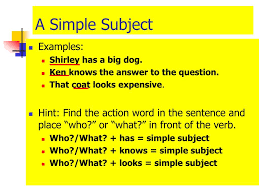Understanding the “Simple Subject” – The Backbone of Every Sentence

Introduction: Why the Simple Subject Matters
In the grand world of grammar, certain concepts get overlooked because they seem too basic to matter. The “simple subject” is one of them. But don’t be fooled by the word “simple”—this little guy is the unsung hero of every sentence you’ve ever spoken, written, or read. If you want to write clearly, speak effectively, or understand English at a deeper level, mastering the simple subject is a must.
At its core, the simple is the main noun or pronoun in a sentence—the person, place, thing, or idea that the sentence is about. It doesn’t include any modifiers or descriptions. In the sentence “The tall boy ran quickly,” the simple subject is just “boy.” Everything else is extra flavor.
Understanding the subject helps not just in grammar classes or writing assignments—it sharpens your overall communication skills. Whether you’re drafting an email, writing a blog, or preparing a speech, a strong grasp of subjects ensures your message is structured and clear.
What Is a Simple Subject, Exactly?

Let’s break it down. A sentence is typically made of two essential parts: the subject and the predicate. The subject tells us who or what the sentence is about, and the predicate tells us what the subject is doing or what is being said about the subject. Thef subject is the core noun or pronoun that everything else in the subject revolves around.
Take this example:
“The friendly neighborhood cat with white paws slept peacefully on the porch.”
Now, what’s the simple subject? It’s “cat.” All the other words describe or give more detail, but cat is the star of the show.
It’s easy to confuse the complete subject with the subject. The complete subject includes all the modifiers and additional information. The subject strips all of that away and leaves just the one word that answers the question: Who or what is this sentence about?
subjects are crucial because they anchor the sentence. Without them, your message floats without a clear purpose. It’s like a movie without a main character—something just feels off.
Identifying the Simple Subject in Different Sentence Types
The subject doesn’t always shout to be noticed. Sometimes it hides behind layers of description, or gets tangled in complex sentence structures. Let’s look at how it appears in various sentence types.
1. In declarative sentences
Declarative sentences are the most common and straightforward. For instance:
“My brother plays guitar.”
Here, “brother” is the subject. No surprises there.
But even in longer, more detailed sentences, you can find the subject by asking “Who or what is doing the action?”
“The little girl with the red shoes danced gracefully.”
Simple subject? Just “girl.”
2. In interrogative sentences
Questions can trick you into missing the subject. For example:
“Does your father like coffee?”
Even though the sentence starts with “Does,” the simple subject is “father.”
A good trick is to rearrange the sentence into a statement: “Your father does like coffee.” That helps isolate the subject more easily.
3. In imperative sentences
These are commands or instructions. Often, the subject is you, but it’s understood rather than directly stated:
“Close the door.”
Who’s supposed to close the door? You. So the simple subject is the implied “you.”
This is a handy reminder that sometimes the subject isn’t explicitly written, but it’s still there.
Simple Subject vs. Compound Subject
Not every sentence is content with just one simple subject. Sometimes, two or more nouns or pronouns team up to form what’s called a compound subject. But each noun in the compound subject is still considered a simple subject individually.
Take this sentence:
“Tom and Jerry fight all the time.”
“Tom” is a simple subject. “Jerry” is also a simple subject. Together, they form a compound subject.
It’s important to recognize compound subjects because they affect verb agreement. In the example above, we use the plural verb “fight” because both Tom and Jerry are subjects.
Understanding this helps improve your sentence structure and avoid those annoying subject-verb agreement mistakes. And believe me, they can sneak into even the best writers’ work if you’re not paying attention.
Common Mistakes When Identifying the Simple Subject
Let’s be honest—grammar can be tricky. Even something as “simple” as the simple subject can trip people up. Here are some common pitfalls:
1. Confusing modifiers for the subject
“The group of noisy children ran through the hallway.”
Many people might say “children” is the simple subject, but it’s not. The correct simple subject is “group”. The phrase “of noisy children” is just a prepositional phrase modifying “group.”
2. Getting misled by introductory phrases
“Running through the field, the dog barked excitedly.”
It might be tempting to think “Running” is the subject, but it’s part of an introductory phrase. The real subject is “dog.”
3. Mistaking the object for the subject
“There are many reasons for his success.”
Inverted sentence structures like this can be misleading. The simple subject here is “reasons.” Rearranging the sentence—“Many reasons are there for his success”—can help reveal the true subject.
Being aware of these common mistakes makes you more conscious of your grammar, and over time, identifying the simple subject becomes second nature.
Why Understanding the Simple Subject Helps Your Writing
Okay, so we’ve dissected what a simple subject is and how to identify it. But how does that actually help your writing?
1. Clarity and focus
Knowing the simple subject keeps your sentence grounded. It makes sure your reader understands exactly who or what you’re talking about. That clarity prevents confusion and makes your writing more direct and impactful.
2. Better sentence construction
Understanding sentence structure at the subject level helps you build stronger, more varied sentences. You become more aware of how your sentences function—and that leads to more polished writing.
3. Grammar and editing confidence
When you know how to find the simple subject, you can spot errors more easily. For instance, you’ll notice if your verb doesn’t agree with your subject or if your sentence is missing a subject altogether. That kind of precision turns a decent writer into a great one.
Practical Exercises to Practice Identifying Simple Subjects
Let’s put your skills to the test. Try identifying the simple subject in the following sentences:
- The pile of books on the table is getting dusty.
- My friends and I are planning a road trip.
- There goes the neighborhood cat again.
- Hiking up the steep trail was exhausting.
- The stories she tells are unbelievable.
Answers:
- pile
- friends, I (compound subject)
- cat
- Hiking
- stories
Practicing with examples like these reinforces the concept. Over time, identifying the subject becomes automatic—just like reading or riding a bike.
Conclusion: Keep It Simple, Keep It Strong
The simple subject might sound like a small concept, but it plays a massive role in your writing, communication, and overall grasp of the English language. Once you understand how to spot it and why it matters, you unlock a deeper level of control over your sentences.
So next time you write, pause and ask: What’s the simple subject here? That little check can make a world of difference in the clarity and impact of your words.
Whether you’re a student, a teacher, a blogger, or someone just looking to write better, mastering the simple subject is a step in the right direction. Simple doesn’t mean unimportant.
In grammar—and in life—the simple subject things are often the most powerful.



